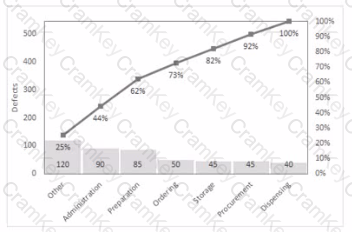The chart provided in the question shows the number of defects in different categories of a medication system. The category with the highest number of defects is “Other,” followed by “Administration.” However, the line graph overlaid on the bar graph shows the percentages of cumulative defects addressed, which increases from left to right. This suggests that while a significant portion of the defects in the “Other” category have been addressed, there are still many unaddressed defects in the “Administration” category.
Given this information, the next step for the healthcare quality improvement team would be to conduct further analysis on the “Administration” defects. This is because, although the “Administration” category does not have the highest number of defects, it has a significant number of defects that have not yet been addressed. Further analysis would help the team understand the root causes of these defects and develop effective strategies to address them123.
This approach aligns with the principles of healthcare quality improvement, which emphasize the importance of using data to guide decision-making and prioritizing areas where improvement is most needed123. It also aligns with the principles of Failure Mode and Effects Analysis (FMEA), a structured process used to identify system failures of high-risk processes before they occur1. In this context, the “Administration” defects could be considered a high-risk process that requires further analysis.
Please note that this answer is based on the general principles of healthcare quality improvement and the information provided in the chart. The specific action plan for addressing medication system defects may vary depending on the specific context and needs of the healthcare organization123.
